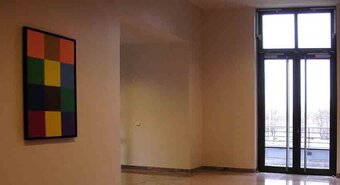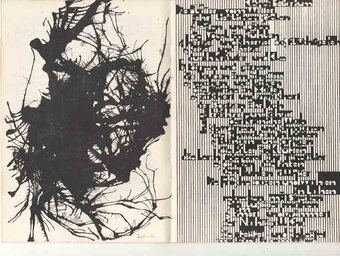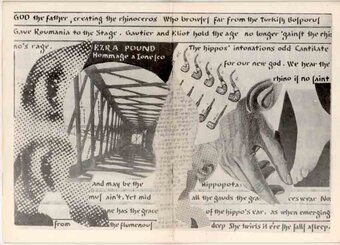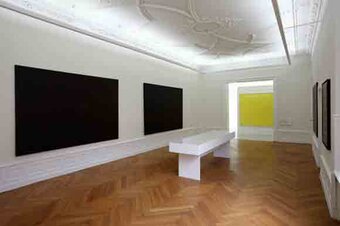Rolf-Gunter Dienst
June 5 to July 24, 2005: Painting and graphics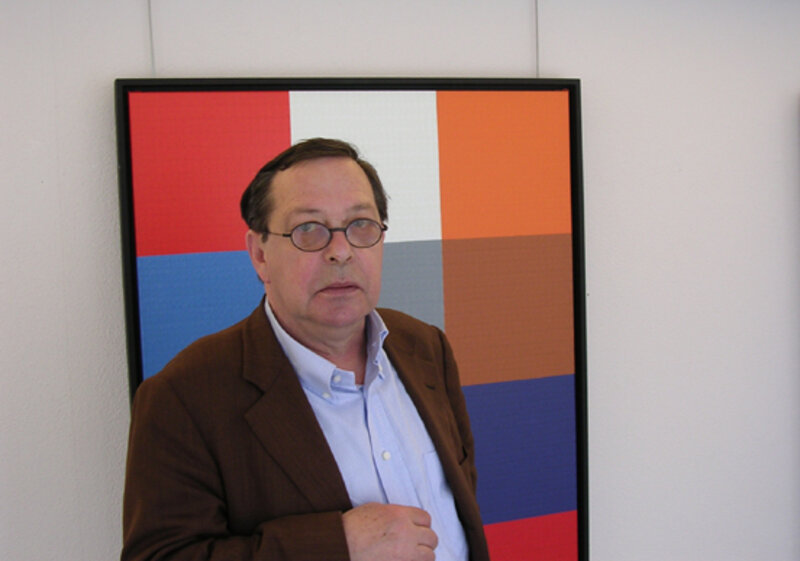
Rolf-Gunter Dienst in front of "Scaramouche VII" 120x190 cm, 2000
Exhibitions
- 1969, Von der Heydt-Museum Wuppertal, Staatliche Kunsthalle Baden-Baden
- 1988, Kunsthalle Kiel, Wilhelm-Hack-Museum Ludwigshafen, Haus am Waldsee Berlin
- 1992, Museum am Ostwall Dortmund
- 1998, Von der Heydt-Museum Wuppertal
- 2000, Appel and Troschke Gallery Frankfurt
- 2001, Kunsthalle Kiel
- 2002, Kunstmuseum Bayreuth, Galerie Appel Frankfurt, Staatliche Kunsthalle Karlsruhe, Museum für neue Kunst Freiburg, Kunsthalle Baden-Baden
Collections
Kunsthalle Kiel, Kunsthalle Mannheim, Museum Morsbroich Leverkusen, Pfalzgalerie Kaiserslautern, Städtische Galerie Wolfsburg, Wilhelm Hack-Museum Ludwigshafen.
Rolf-Gunter Dienst began his artistic career as an art critic and art writer. He published the magazine "Das Kunstwerk". In 1965, he founded the artist group SYN with Bernd Berner, Klaus Jürgen-Fischer, Erwin Bechtold and Eduard Micus.
His painting refers less to the "mathematics of concrete art" and more to the elaboration of macro and micro structures. In this sense, looking is required. His paintings are "visual works" that challenge the aesthetic faculty of perception.
Vita
- Born in Kiel in 1942.
- 1960-1965 Editor of the literary magazine Rhinozeros.
- 1964-1991 editor of the magazine Das Kunstwerk.
- 1965-1970 member of the artist group SYN.
- 1966-1968 Guest lecturer in New York.
- 1968 Villa Romana Prize/Florence.
- 1970 Visiting lecturer in Frankfurt.
- 1977 Visiting lecturer in Sydney.
- 1979 Villa Massimo Prize/Rome.
- 1982 Prize of the Society of Friends of Young Art/Baden-Baden.
- 1991 Cross of Merit with Ribbon.
- 2007 Hans Thoma Prize.
- 1989-90 Guest lecturer in Stuttgart.
- 1992-2008 Professor at the Academy of Fine Arts Nuremberg.
- Lives and works in Baden-Baden and Kauffenheim/Alsace.
Painting poetry: On the pictorial poetics of Rolf-Gunter Dienst
In the entrance hall, a narrow corridor to the right of reception leads to the Roskamm House. Shortly before the outpatient clinic, an anteroom opens up with a large-format painting by Rolf-Gunter Dienst. It is made up of colored squares and bears the title Scaramouche VII from the year 2000. Is the title to be understood as an allusion to the 1952 US film Scaramouche, the Gallant Marquis by George Sidney with Stewart Granger and Janet Leigh, or does it refer to the comic figure from the Italian popular theater Commedia dell Arte? It is probably up to the viewer to decide. But what is the film and/or theater hero Scaramouche trying to tell us? Are episodes from the life of this character hidden behind the colored squares? Does the colored square represent a disguised letter or a word that tells a story in combination with the other squares? A fascinating thought: Dienst's painting is more than just a picture; it can be described as "picture poetry".
In the Ars poetica, Horace formulates an idea that is still valid today in the visual arts: the poem is a speaking image, the painting is silent poetry. During the Renaissance and Baroque periods, this was referred to as painting poetry. The narrative painting, such as the coarse conversation pieces by Jan Steen, stands in contrast to the word, which is able to conjure up images in the imagination of the listener.
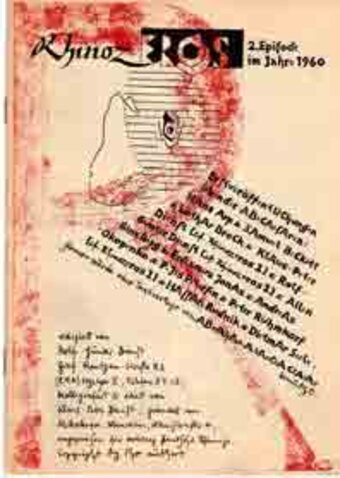
Not so many years ago, in 1975, the US writer Tom Wolfe published a book entitled The Painted Word, in which he claimed that, among other things, the artistically designed letter must be emphasized as the birthplace of Pop Art.
Tom Wolfe's reflections have remained topical and today offer themselves to a certain extent as an access aid to the work of Rolf-Gunter Dienst, although he is certainly not part of Pop Art. Long before the publication of the aforementioned book, Dienst published the calligraphically designed art and literature magazine Rhinoceros together with his brother Klaus-Peter between 1960 and 1965.
In the first issue of 1960, a fascinating intermediate realm of image and letter opens up. The text is barely legible, but it can be understood - in different ways for everyone - if one interprets the iconic message. After a while, the letters appear in familiar word formations, which may refer to the curly blobs on the opposite page. Meaning is revealed, perhaps even a message - for some it is rich in imagery and color, for others it is nonsensical.
The letter is a sign that points the way to the word and its meaning. Words are formed into sentences with statements that can be interpreted in different ways. However, as a design motif, the letter can also point the way to the word and sentence image, which can be read on an aesthetic and linguistic level. Both levels combine to form a pattern that goes beyond both the linguistic and the pictorial message. But this message cannot be described (although I am trying in vain right now), as it is individual and therefore emotional.
The viewer's imagination is required. If I actually engage with the pictures, I can't just study the color combinations and check whether they are a feast for my eyes. That is not enough.
Let's stay with the Commedia dell'Arte, with Scaramouche, this deceitful braggart who is laughed at by the lovely Zerbinetta and beaten up by Harlequin. That is a story! If we assign color squares to the characters and scenes, then we are in the picture, which has already been transformed into a stage spectacle.
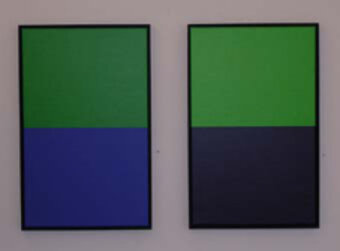
n.d., 2001
But if we don't know the artists and plot sequences of the Commedia dell'Arte and don't even know who is behind the name Scaramouche? Then we should simply think up a story, or a recent everyday scenario, or simply recall fragments of experiences and associate them with the color squares.
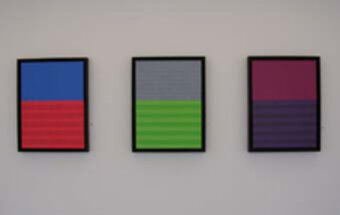
Piccolo, 2000
There are many ways to read Dienst's paintings. And if I have just mentioned a stage spectacle, then this is not far-fetched, as Dienst not only chooses the gallery wall as the support for his paintings, but also the space. At the end of 2012, the artist used his paintings to decorate rooms in the "Kunstsaele Berlin" gallery. The large-format and partly monochrome works radiated their rhetorical presence in juxtaposition and succession, but not as individual objects. Perhaps this was the true stage for Rolf-Gunter Dienst - much like the magazine Rhinoceros decades earlier.
2012 was a significant year for the artist. He celebrated his 70th birthday. An exhibition was held in his honor at the Fruchthalle Municipal Gallery in Rastatt. It was entitled: I'll just keep on.


